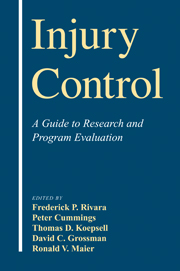Book contents
- Frontmatter
- Contents
- List of Contributors
- 1 An Overview of Injury Research
- 2 Classifying and Counting Injury
- 3 Measurement of Injury Severity and Co-morbidity
- 4 Data Linkages and Using Administrative and Secondary Databases
- 5 Rates, Rate Denominators, and Rate Comparisons
- 6 Data Collection Methods
- 7 Selecting a Study Design for Injury Research
- 8 Qualitative Methods in Injury Research
- 9 Randomized Trials
- 10 Cohort Studies in Injury Research
- 11 Case–Control Studies in Injury Research
- 12 Ecologic Studies
- 13 Case Series and Trauma Registries
- 14 Systematic Reviews of Injury Studies
- 15 Evaluating an Injury Intervention or Program
- 16 The Development of Clinical Decision Rules for Injury Care
- 17 Trauma Performance Improvement
- 18 Measuring Disability and Quality of Life Postinjury
- 19 Economic Evaluation of Injury Control
- 20 Ethical Issues
- Index
11 - Case–Control Studies in Injury Research
Published online by Cambridge University Press: 16 October 2009
- Frontmatter
- Contents
- List of Contributors
- 1 An Overview of Injury Research
- 2 Classifying and Counting Injury
- 3 Measurement of Injury Severity and Co-morbidity
- 4 Data Linkages and Using Administrative and Secondary Databases
- 5 Rates, Rate Denominators, and Rate Comparisons
- 6 Data Collection Methods
- 7 Selecting a Study Design for Injury Research
- 8 Qualitative Methods in Injury Research
- 9 Randomized Trials
- 10 Cohort Studies in Injury Research
- 11 Case–Control Studies in Injury Research
- 12 Ecologic Studies
- 13 Case Series and Trauma Registries
- 14 Systematic Reviews of Injury Studies
- 15 Evaluating an Injury Intervention or Program
- 16 The Development of Clinical Decision Rules for Injury Care
- 17 Trauma Performance Improvement
- 18 Measuring Disability and Quality of Life Postinjury
- 19 Economic Evaluation of Injury Control
- 20 Ethical Issues
- Index
Summary
Introduction
In 1935, a research group in Evanston, Illinois, began measuring the alcohol content in urine from drivers who were hospitalized after a traffic crash. Over 3 years, they found that 47% of 268 injured drivers had been drinking, and 25% had measurements consistent with a blood alcohol level of 21.7 μmol/L or greater. The researchers reasoned that if alcohol use was a cause of traffic crashes, then the prevalence of alcohol in the blood of injured drivers should be greater than that in drivers who had not crashed. To test this hypothesis, they developed a machine which could measure alcohol in expired air. In April of 1938, they towed this machine to several sites in Evanston and measured alcohol levels in 1726 drivers at all hours of the day and night. They found that only 12% of drivers had alcohol in their breath, and only 2% had values consistent with a blood level of 21.7 μmol/L or more. When Holcomb (1938) published these findings, he made no mention of the case–control design, as this term had not yet been coined.
The case–control study design was more formally developed in the 1950s with a series of papers regarding the causes of cancer. The first statistical methods for analyzing these studies, still in use today, were formulated during the same era (Cornfield, 1951; Mantel and Haenszel, 1959). Had the Evanston researchers known these methods, theycould have estimated that the crude relative risk of hospitalization due to a crash was 22 (95% conidence interval, 14–34) for drivers with blood alcohol levels of 21.7 μmol/L or greater compared with drivers with no alcohol in their blood.
Keywords
- Type
- Chapter
- Information
- Injury ControlA Guide to Research and Program Evaluation, pp. 139 - 156Publisher: Cambridge University PressPrint publication year: 2000
- 4
- Cited by

